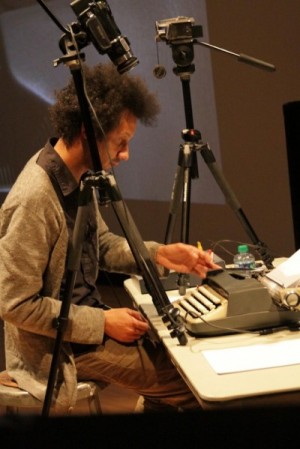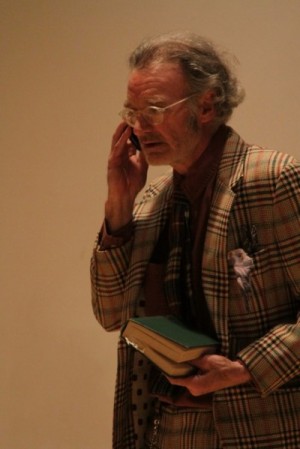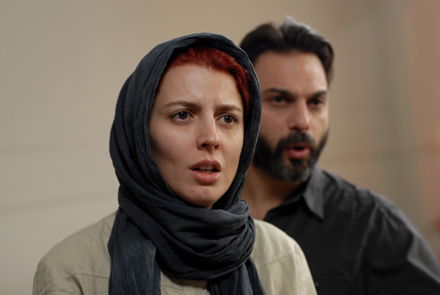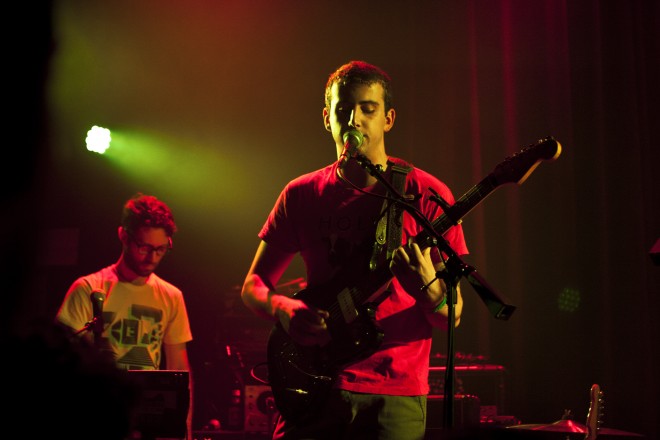Panel #3
Robin Deacon: “Too Beautiful to Be Wasted” Alan Rhodes: “Occupying Virtual Space: AR(t)” Julie Laffin: “Re)collecting Evidence”

So how do you “act out the act of thinking?” Robin Deacon pondered this question in two parts: addressing the process of speaking and writing. To do this, Deacon, an artist, writer and filmmaker, positioned himself with his back to the audience during the entire performance, isolating the audience’s view of his actions to the projector screen as he engaged with two video cameras, one positioned over an old typewriter, and the second positioned to record his mouth when he stood. He began by mouthing the words played from a prerecorded track, his facial movements on the screen not quite in synch with the audio. This disconnect produced a visual image of the mediation that must necessarily come between all thought and expression, exaggerated by the technological apparatus. In the second part, the typewriter became the mediator. The artist punched letters at first deliberately and then at random, as the machine emitted sounds in chaotic contrast to the steady pace of the spoken narration. Deacon began to pound on the keys, seemingly unable to negotiate between what he was thinking and what he was typing, the projection illuminated the gibberish on the page. While, in Deacon’s words, “The art of writing is not very interesting cinematically speaking,” he proved his statement wrong by amusing attendees with the tools of mediation that also distances the creative act from the original idea.
Alan Rhodes, “Occupying Virtual Space: Ar(t),” was introduced by independent curator, Tricia Van Eyck, explaining how Rhodes’ work is an “augmented reality essay on the tradition of video essays.” Through the layering of performance realities, the artist takes the viewer down a rabbit hole of the virtual selves of Alan Rhodes. The audience saw Rhodes in real time as he was sitting at the table in front of his laptop, as well as doubled on the projector screen through the computer’s camera. The artist held up white cards with graphics (QR codes), which the camera read and translated into video, the majority of which featured Rhodes in the same outfit he wore that day. Rhodes was playing with the idea of manipulation of virtual space, exploring “augmented reality,” and video mediation. The artist asked two questions, “So what?” and “Who cares?” and found that the answer to the first question lay in the second. How can we regulate an augmented reality if information space is controlled space? The sense of limitlessness is conveyed in Rhodes’ performance, yet, at the same time the sense of noise becomes overwhelming; Rhodes’ layering of virtual spaces makes it difficult for one to distinguish between the many modes of communication.
If you missed the performance, Rhodes’ virtual essay can be experienced here: “AR on AR – Occupying Virtual Space” – a presentation by GARhodes.

The third artist in this panel, Julie Laffin, performed “Re)collecting Evidence,” exploring how the possibility of the lecture format can augment performance. Through virtual spaces, Skype and video, the artist investigated dualities: individuality and the collective, memory and reality, industrial and the natural environment. The audience listened and watched a performance on the projector screen, pre-recorded but addressing the audience directly. Inviting the audience into a virtual landscape of the American southwest, we came to understand this as the artist’s home. Then, the artist discussed how her illness, called environmental illness, has prevented her from being around others in an unmediated environment, and what’s more, preventing her from being a part of the performance community (a “community” in the traditional sense of the word). The artist explained, “I can only experience other people’s work through mediatized representations…”
Through Skype, the artist described how elements of representation and reproduction allowed her to experience performance art in new ways. In a sense, machines and the industrialize world have both caused and reconciled her exile. Interestingly, this performance felt the most immersive out of the three, but was in fact still a mediated situation. Near the end, Laffin thanked the audience for coming (virtually) to her performance, and was grateful for everyone who had made the trip. Indeed, I really felt like I had traveled somewhere. So much that Laffin gave us directions as to how to get back to Chicago:
She says it’s about a 27-hour drive. Laffin recommends to take the 77 North, take the Holbrook, then catch I-40, head East to Albuquerque, recommends going through Wichita, skip St. Louis, continue on to Des Moines, Iowa…
Intervention #3
Sally Alatalo and Simon Anderson: “Apparently they fished someone out of the river.”
“…Hello? No, I’m not going to call you back. I’m nearly finished. Just let me finish this bit… No, just carry on. Alright, thanks. Bye.”
– Simon Anderson







